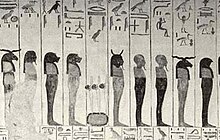The Litany of Re (or more fully "Book of Praying to Re in the West, Praying to the United One in the West") is an important ancient Egyptian funerary text of the New Kingdom.[1] Like many funerary texts, it was written on the inside of the tomb for reference by the deceased. Unlike other funerary texts, however, it was reserved only for pharaohs or very favored nobility.

It is a two-part composition that in the first part invokes the sun, Ra, in 75 different forms. The second part is a series of prayers in which the pharaoh assumes parts of nature and deities, but mostly of the sun god. Developed in the Eighteenth Dynasty, it also praises the king for his union with the sun god, as well as other deities. The text was used in the entrance of most tombs from the time of Seti I, though we first know of it from the burial chamber of Thutmose III and the tomb of his vizier Useramun.

See also[edit]
References[edit]
- ^ Hornung (1999) p.136
touregypt.com- The Litany of Re
Further reading[edit]
- Hornung, Erik (1999). The Ancient Egyptian Books of the Afterlife (in German). David Lorton (translator). Cornell University Press.

Well, that’s interesting to know that Psilotum nudum are known as whisk ferns. Psilotum nudum is the commoner species of the two. While the P. flaccidum is a rare species and is found in the tropical islands. Both the species are usually epiphytic in habit and grow upon tree ferns. These species may also be terrestrial and grow in humus or in the crevices of the rocks.
View the detailed Guide of Psilotum nudum: Detailed Study Of Psilotum Nudum (Whisk Fern), Classification, Anatomy, Reproduction